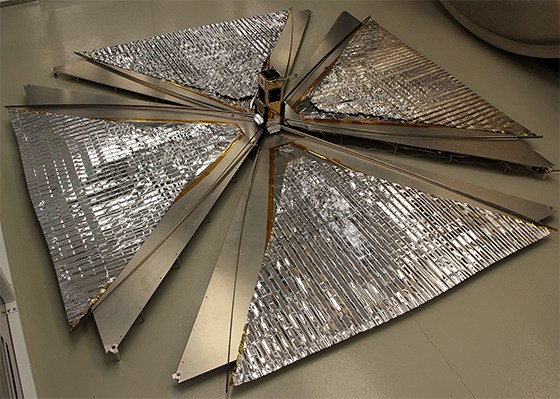Space Flight Laboratory Kicks Off Nanosatellite Deorbiting Demo

CanX 7 with drag sails deployed prior to launch. Photo: SFL.
After collecting more 4.3 million Automatic Dependent Surveillance-Broadcast (ADS-B) messages from aircraft since it launched in September 2016, the 3.5 kilogram 10 by 10 by 34cm CanX 7 nanosatellite deployed its four drag sails yesterday evening. Space Flight Laboratory (SFL) built CanX 7 at the University of Toronto Institute for Aerospace Studies (UTIAS).
Each drag sail has an area of approximately one square meter. The sails are intended to decrease the ballistic coefficient of the satellite and use atmospheric drag to accelerate orbital decay. According to SFL, the drag sail technology is important for nano- and microsatellites whose Low Earth Orbital (LEO) presence would exceed the Inter-Agency Space Debris Coordination Committee (IADC) guidelines that limit such presence to 25 years after end of mission.
“Such compliance is essential to ensuring that space debris is mitigated for the world. It is also a critical component in satisfying regulatory bodies so that small satellite missions may proceed uninhibited,” said SFL Director Robert Zee.
CanX 7 completed a seven-month campaign to collect ADS-B messages from aircraft to demonstrate Canada’s first ADS-B data collection from space. With that phase of the mission successfully completed, the satellite deployed its drag sails to begin the second phase of the mission. The sequential phases were intended to emulate an operational mission followed by deorbiting. A key component in the drag sail technology demonstration was long-term stowage of the drag sail modules in space without interrupting or affecting the operational mission.
During this final phase of the CanX 7 mission, the deorbiting process will be closely monitored via the SFL ground station in Toronto. SFL will determine and compare orbital decay rate against pre-launch simulation results.